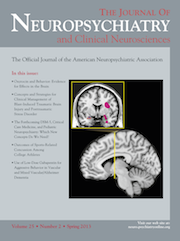Schizencephaly and Borderline Personality Disorder
To the Editor: Schizencephaly is a kind of poroencephaly characterized by gray-matter lined clefts of the cerebral mantle. It is caused by an abnormal neural migration that can be identified by ultrasound after the 20th week of gestation. Young maternal age is a risk factor. Its prevalence has been estimated as 1.54/100,000.1 There are very few case reports in the literature describing the psychiatric comorbidity of schizencephaly.
Case Report
This is a 28-year-old man who presented to the emergency department complaining of depressive symptoms and suicidal ideation, with a plan to overdose. His urine toxicology screen was positive for cocaine. His CT scan of the head showed a cleft by gray matter extending from the margin of the right posterior frontal lobe to the margin of the lateral ventricle, consistent with schizencephaly. Neurological exam was significant for left-sided hemiparesis, with decreased strength and sensation. He reported a childhood history of ADHD and reading disorder.
The patient admitted to chronic suicidal ideation and feelings of emptiness. He had taken several overdoses that led to psychiatric inpatient admissions. He reported severe mood swings that would last for a few hours, on average. He had started using marijuana at the age of 7 years and cocaine at the age of 15 years and had been in jail for 5 years after being charged with drug possession. He had been involved in multiple fights and had a big scar in his face after being stabbed by another man. The patient had multiple tattoos on his body with extreme statements such as “love” and “hate,” “life” and “death,” and derogatory comments against authorities. He had had several girlfriends, but acknowledged that he had not been able to establish intimacy with any. He reported hearing the voice of a man and a woman intermittently saying that he is not worth it. He showed frantic efforts to avoid abandonment; every time he was offered discharge, he stated that he was getting worse and stated on repeated occasions that he would commit suicide.
Discussion
The patient met DSM-IV criteria for borderline personality disorder with antisocial traits. This is the second case in the literature of a patient with borderline personality disorder and schizencephaly.2 Frontal cortex dysfunction is thought to contribute to the impulsivity features of borderline personality disorder.3 This case further supports the theory that frontal lobe lesions may play a role in the pathophysiology of cluster B personality disorders.
1 : Schizencephaly: heterogeneous etiologies in a population of 4 million California births. Am J Med Genet A 2005; 137:181–189Crossref, Medline, Google Scholar
2 : Borderline personality features possibly related to cingulate and orbitofronta cortices dysfunction due to schizencephaly. Clin Neurol Neurosurg 2008; 110:396–399Crossref, Medline, Google Scholar
3 : Borderline personality disorder, impulsivity, and the orbitofrontal cortex. Am J Psychiatry 2005; 162:2360–2373Crossref, Medline, Google Scholar



